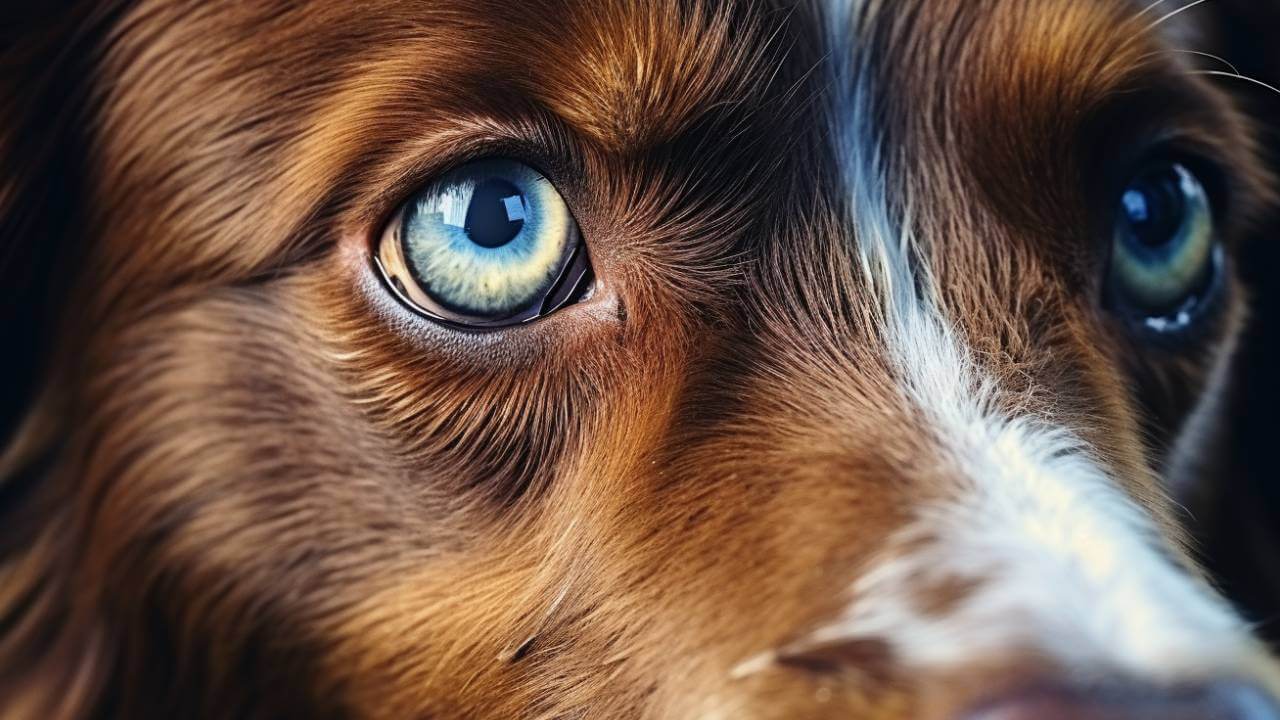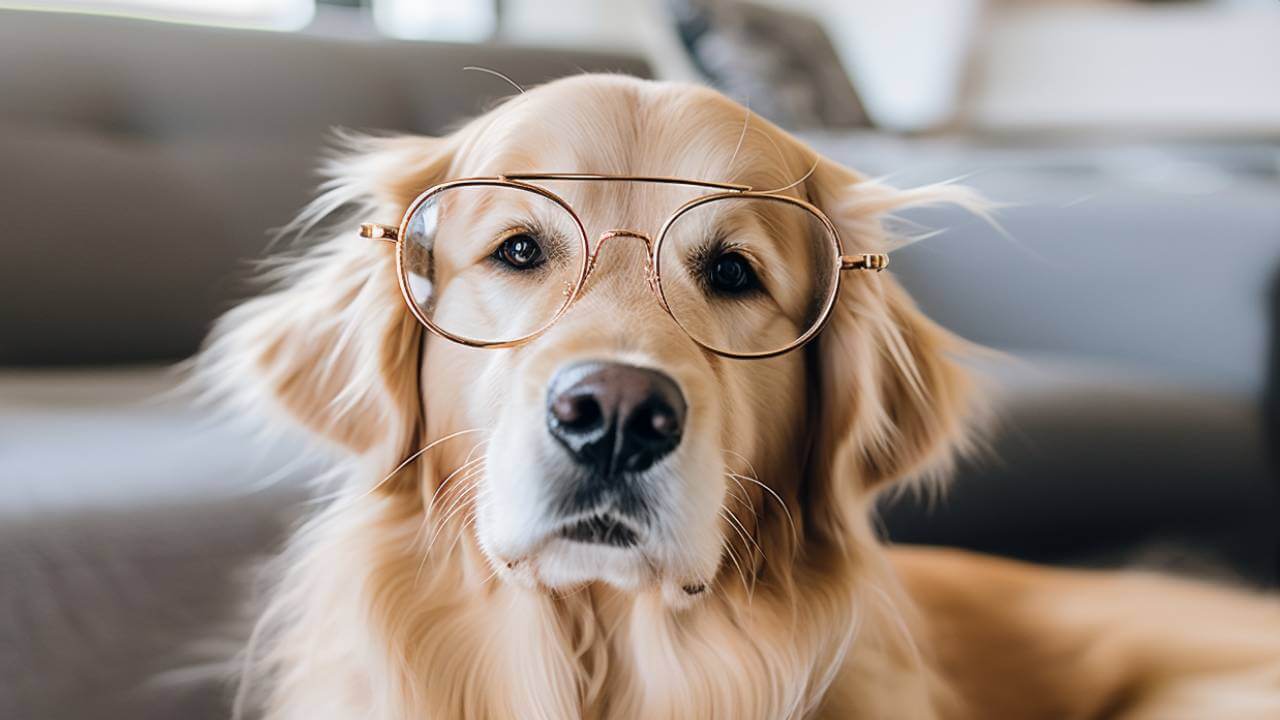When we think of our canine companions, we often picture them with bright, expressive eyes, eagerly gazing at the world around them. However, just like humans, dogs can experience vision loss, which can be distressing and challenging for both the pet and their owner.
This guide will delve into the intricate world of “vision loss in dogs.” We’ll explore what it means, its causes, and, most importantly, how to recognize the causes of vision loss in dogs and the signs of dog vision loss. By the end, you’ll better understand how to manage vision loss in dogs and blind dog adjustment.
What is Vision Loss in Dogs?
Vision loss in dogs, often called canine blindness, occurs when a dog’s eyesight deteriorates to the extent that it experiences partial or complete vision loss. The extent of vision loss can vary, with some dogs experiencing total blindness while others may retain limited or peripheral vision.
“Please perform regular health exams for your pet, including an ophthalmology exam, blood work, and urinalysis. Don’t hesitate to ask your vet more questions. Early addressing these symptoms with a veterinarian can save your dog’s life and healthy being!” – Veterinarian Mykhailo Ozmenchuk.
Signs and Symptoms of Blindness in Dogs
Regardless of the degree of blindness, dog owners should be able to recognize the signs and symptoms early to ensure their furry friends receive the care and support they need.
- When your agile dog begins clumsily bumping into furniture or seems disoriented in dim light, it might signal vision troubles.
- Nighttime confusion or unease points towards difficulty seeing in low light, often a precursor to broader vision impairment.
Observing your dog’s eyes for cloudiness, redness, or discharge is crucial, as these changes can indicate underlying eye conditions.
Moreover, if your dog reacts with surprise to sounds or movements, it may be because they can’t see what’s approaching. A shift towards more cautious behavior, decreased enthusiasm for play, or an uptick in indoor accidents suggests they struggle to navigate their familiar environment.
Also, a sudden disinterest in activities that require sight, like tracking moving objects or gazing out the window, can underscore a loss of vision. Securing dog insurance can alleviate some of the financial burdens associated with surgeries and medications.

Causes of Vision Loss in Dogs
Recognizing the causes of blindness in dogs and how they lead to their vision challenges, we can navigate this journey of caring for a blind dog with empathy and knowledge.
Age-Related Vision Degeneration: Their eyes may change as dogs age, leading to cataracts, glaucoma, and retinal degeneration. Cataracts, for example, cloud the lens of the eye, gradually diminishing vision. Some breeds are more prone to hereditary eye conditions. Age-related vision degeneration is common in older dogs. Aging in dogs explores how aging affects your canine companion, including their eyesight.
For instance, species like the Dachshund and Poodle have a higher risk of developing progressive retinal atrophy (PRA), which can ultimately lead to blindness.
Eye Infections and Diseases: Infections, injuries, and diseases can significantly impact a dog’s vision. If left untreated, conditions like conjunctivitis, keratitis, and uveitis can cause pain, discomfort, and vision loss. Accidents or physical trauma can damage a dog’s eyes, impairing vision. In such cases, seeking immediate veterinary care to assess and address the damage is vital.
Medication Side Effects: Certain medications, mainly when administered over a prolonged period, can have side effects that affect a dog’s vision. It’s essential to be aware of these potential side effects and consult your vet if you notice any concerning changes in your dog’s eyes.
Diagnosing Dog Vision Problems
Timely and accurate diagnosis is essential for addressing vision loss in dogs. Here’s how veterinarians diagnose vision problems in canines:
- Comprehensive Eye Examination A thorough eye exam by a veterinarian is the first step in diagnosing vision issues. This includes evaluating the eye’s structure, checking for abnormalities, and assessing the dog’s vision.
- Vision Tests Veterinarians often conduct various vision tests to assess the dog’s visual capabilities. These tests may include obstacle courses, tracking moving objects, and the ‘menace response,’ where a dog blinks in response to an approaching hand or object.
- Referral to Veterinary Ophthalmologist In complex cases, your veterinarian may refer you to a veterinary ophthalmologist specializing in diagnosing and treating eye conditions in dogs.
These specialists have access to advanced equipment and can provide a more accurate diagnosis.

Managing Vision Loss in Dogs
Managing vision loss in dogs depends on the underlying cause and the extent of the condition. Here are some standard treatment options:
Medication: If the vision loss is due to an eye infection or inflammation, veterinarians may prescribe medication to treat the underlying condition.
Surgery: Surgical procedures, such as cataract removal, can sometimes restore vision. However, surgery may not be suitable for all dogs, and the decision should be made in consultation with a veterinarian.
Lifestyle Adjustments: Blind dogs can adapt well to their condition with some lifestyle adjustments. Creating a safe and consistent environment is crucial. This includes avoiding changes in furniture placement, using scent markers, and using verbal cues.
Supportive Care: Dogs with irreversible vision loss will require ongoing supportive care. This may involve regular veterinary check-ups, pain management, and dietary adjustments to maintain health and well-being.
Helping Your Dog Adjust to Blindness
Helping a dog adjust to blindness involves patience, love, and some practical steps to ensure they feel safe and confident in their environment. Here’s how you can support your blind dog:
- Maintain a Consistent Environment: Keep your home layout the same to help your dog memorize and navigate the space safely. Avoid moving furniture and keep pathways clear of obstacles.
- Safe Exploration: Encourage your dog to explore safely within the home or yard by initially guiding them gently on a leash. Use verbal cues to warn of steps or obstacles until they learn to navigate independently.
- Enhance Other Senses: Use toys that make noise or have strong scents to stimulate their play and exploration. This can help compensate for the loss of vision and keep their other senses sharp.
- Routine is Key: Keep a consistent routine for feeding, walks, and playtime. Predictability helps a blind dog feel secure.
- Training and Commands: Reinforce or retrain commands to help guide your dog. Commands like “step up”, “step down”, “stop”, or “careful” can be very useful for a blind dog to navigate spaces safely.
Consider using a playpen for dogs to create a secure area where they can familiarize themselves with their surroundings safely.
Understanding and addressing vision loss in dogs is crucial for their well-being and our deep bonds with our canine companions. With proper care, support, and love, blind dogs can lead fulfilling lives, demonstrating the remarkable resilience and enduring spirit that makes them our cherished friends.

FAQs
Can dogs adapt to sudden blindness?
They rely on their other senses, such as smell and hearing, to compensate. You can help by keeping their environment consistent, using scent markers and sound cues for navigation, and maintaining a routine to give them confidence and security.
Are certain dog breeds more prone to developing blindness?
Some breeds are genetically predisposed to conditions that can lead to blindness, such as Progressive Retinal Atrophy (PRA) in Cocker Spaniels, Labrador Retrievers, and Poodles, or glaucoma in Basset Hounds and Shih Tzus. Regular eye exams can help in early detection and management.
How can I tell if my dog is going blind in one eye?
Signs that your dog might be losing vision in one eye include bumping into objects on one side, squinting, or a lack of response when you wave your hand on the affected side (without creating air movement). If you notice these signs, an eye vet exam is crucial.
To understand these conditions and their treatments, dog diseases can lead to vision impairment.
What are the latest treatments for preventing or slowing down blindness?
Advancements in veterinary medicine offer various treatments, including medications to control conditions like glaucoma, surgical interventions for cataracts, and even gene therapy for inherited disorders. Consult a veterinary ophthalmologist to explore all available options.
Is it safe to take a blind dog to new, unfamiliar places?
Introduce them to new places consistently and calmly, provide plenty of verbal cues, and ensure they’re on a leash for safety. These outings can be enriching experiences, stimulating their other senses and enhancing their well-being.






Dealing with the possibility of my dog losing vision is scary. Your article on blindness in dogs was informative and comforting. Do you have any tips for helping blind dogs adjust to their surroundings? 🐶💔
Are there any preventative measures we can take to protect our canine companions’ vision?